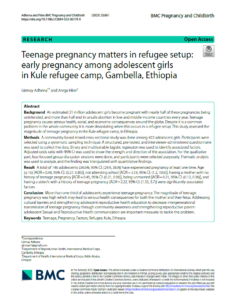
Background
An estimated 21 million adolescent girls become pregnant with nearly half of these pregnancies being unintended, and more than half end in unsafe abortion in low and middle-income countries every year. Teenage pregnancy causes serious health, social, and economic consequences around the globe. Despite it is a common problem in the whole community it is more devastating when this occurs in a refugee setup. This study assessed the magnitude of teenage pregnancy in the Kule refugee camp, in Ethiopia.
Methods
A community-based mixed cross-sectional study was done among 422 adolescent girls. Participants were selected using a systematic sampling technique. A structured, pre-tested, and interviewer-administered questionnaire was used to collect the data. Binary and multivariable logistic regression was used to identify associated factors. Adjusted odds ratio with 95% CI was used to show the strength and direction of the association. For the qualitative part, four focused group discussion sessions were done, and participants were selected purposely. Thematic analysis was used to analyze, and the finding was triangulated with quantitative findings.
Result
A total of 146 adolescents (34.6%, 95% CI: (29.9, 38.9)) have experienced pregnancy at least one time. Age (≤ 16) [AOR = 0.48, 95% CI: (0.27, 0.85)], not attending school [AOR = 3.59, 95% CI: (1.2, 10.8)], having a mother with no history of teenage pregnancy [AOR = 0.45, 95% CI: (0.21, 0.98)], being unmarried [AOR = 0.21, 95% CI: (0.12, 0.36)], and having a sister/s with a history of teenage pregnancy [AOR = 2.22, 95% CI: (1.33, 3.7)] were significantly associated factors.
Conclusion
More than one-third of adolescents experience teenage pregnancy. The magnitude of teenage pregnancy was high which may lead to serious health consequences for both the mother and their fetus. Addressing cultural barriers and strengthening adolescent reproductive health education to decrease intergenerational transmission of teenage pregnancy through community awareness and strengthening reproductive parent-adolescent Sexual and Reproductive Health communication are important measures to tackle the problem.